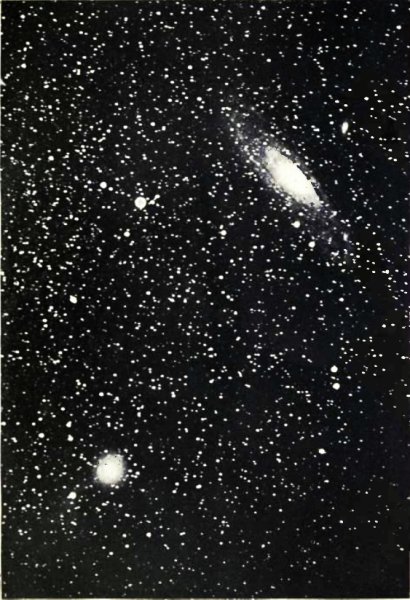Comet Holmes: Then and Now
 Mon 2007-10-29
Mon 2007-10-29 
Earlier this evening I went outside with Zoe to look for Comet Holmes which has recently undergone something of an outburst. Immediately on stepping out of the front door it was obvious as a 2nd-magnitude star-like object a few degrees from Alpha Persei in the direction of Capella. Through binoculars it was a circular ball of fuzz, contrasting nicely with the sharp pin-points stars in Alpha Persei Cluster. No sign of a tail. The integrated brightness was just a little below that of Algol at maximum, say magnitude 2.3 or 2.5.
But for me Comet Holmes means the above photo taken by Edward Emerson Barnard back in 1892. This photo appears as Plate 18 in Ball's Popular Guide to the Heavens, one of the books that sparked my interest in Astronomy when I was about the same age that Zoe is now. This is what Ball had to say on this photo:
HOLMES' COMET AND THE ANDROMEDA NEBULA
On Nov. 6, 1892, Mr. Edwin Homes discovered in London a comet which was in many ways remarkable. When found it was close to the great nebula in Andromeda, and its motion was so slow that, throughout the month of November, it could be photographed on the same plate with the nebula. Plate 18 is a reproduction of a photograph taken at the Lick Observatory, on November 10th, by Professor Barnard, who describes the comet as "round and sharply defined like a planetary nebula, with a symmetrical, nebulous atmosphere surrounding it for some distance."
The after-history of this comet is very curious. By the middle of December, it had grown so exceedingly faint and ill-defined that scarcely any telescope could show it. But, in the middle of January, it suddenly brightened up, and condensed into a small, hazy, star-like object, after which it again became diffuse, and finally vanished.
The comet's orbit was equally remarkable. It lay entirely between Mars and Jupiter, in the zone of minor planets; and it has even been suggested that the comet was not a comet at all, but the result of some celestial accident --such as a collision-- which had befallen an asteroid.

Reader Comments